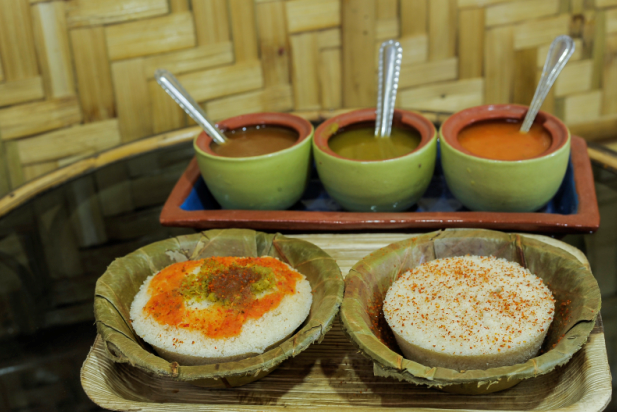
If you were to head out on a winter morning somewhere in Morang, Jhapa, or really anywhere in the eastern Terai of Nepal, one of the first things you’d see would be middle-aged women out in the streets selling piping hot rice cakes in newspapers or taparis(leaf bowls) with a side of noon-khursani (salt and chilli powder) or some home-made sauce.
Bhakka, as this dish is called, is a traditional dish for people of the Rajbanshi, Tharu, and Tajpuria communities. However, in the last two decades, it has grown incredibly popular in the eastern Terai and is now creeping into the palates Kathmanduites as well.
If you are from the eastern Terai, you probably don’t need me to tell you where to get your bhakka. However, for the rest of us valley dwellers, you can try out this dish at Bhakka House, a new restaurant in Old Baneshwor dedicated solely to bhakka.
The thing that makes bhakka enthusiasts come back again and again for this dish is its texture. It has a light spongy texture that most who try it enjoy immensely. Taste-wise, bhakka is rather bland. It is made simply from rice flour and water, so it tastes just like plain rice. What gives the dish its flavor are its accompaniments.
You can have bhakka with many, many accompaniments. Someone from the eastern Terai would probably prefer to have it with noon-khursani, as is traditional. At Bhakka House, on top of noon-khursani, you will find three kinds of sauces, one sweet, one spicy, and one mild tomato achaar, which you can pair with their bhakka. You can also pair it with some chaukuni, a mildly spicy yogurt-based salad native to Palpa that the owners of Bhakka House have cleverly paired with bhakka for the hot summer months. If you still want more options, some people in certain places in the Terai also enjoy their bhakka with fish curry.
The accompaniment for bhakka also seems to vary from place to place. According to the owners of Bhakka House, as bhakka spreads to more places, the types of achaars and accompaniments that go along with it are also increasing.
Bhakka is meant to be eaten hot. “If you let it cool down, it loses its spongy texture and is not really that good anymore,” says Biwash of Bhakka House. So, when you do get around to trying this dish, attack it as soon as it hits your table.
Bhakka is only made using rice flour and water. “There are no other added ingredients,” says Biwash. However, there is a specific method that one needs to follow while making bhakka that is slightly complicated. It is also considered rather healthy, as it uses no oil, sugar, or any other unhealthy ingredient.
Originally believed to be a traditional Rajbanshi cuisine, Bhakka has a rich traditional importance in their culture. “In our culture, we send sel roti and sweets as a koseli(gift) to the bride after a wedding when they first visit their maiden home and return. Among the Rajbanshis, they give bhakka to the bride instead,” explains Biwash.
Outside of Bhakka House, you will find that the majority of bhakka makers and sellers are women, typically Rajbanshi housewives, who sell bhakka in the streets first thing in the morning before returning home for their other daily activities. “Bhakka is a street food. We are the first to open a restaurant (dedicated to bhakka) and create this kind of environment,” says Biwash.
Bhakka also holds a lot of memories for people from the east. “I’ve been eating bhakka since I was little. I did not know how to make bhakka, but since I had the concept for this restaurant, I have learned how to make it,” says Biwash, who has hired a better cook who does the actual cooking of the bhakka. If you look at the sticky notes that previous customers have left on the door of Bhakka House, Biwash is not the only person who fondly remembers bhakka. “Jhapali taste… went back to school days!” says one note, while another comments, “Reminded me of Jhapa after 10 years… missing timurachaar.” There are many more comments like that. Another note says “Loved your bhakka… reminded me of Jhapa”, while yet another note says, “Reminded me of Jhapa and all those cold winter days. Great place and yummy bhakka.”
It is not only Jhapalis who have left their comments. Many others who tried the dish for the first time also sing its praises. “Never tried this amazing food before” says one sticky note, and several others seem to share the same sentiment.
If you like trying new food and if you are interested in exploring traditional Nepalese cuisines, we suggest you try this dish at least once.










